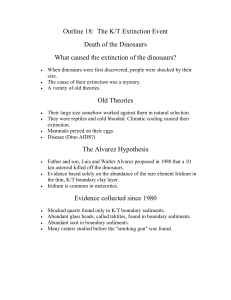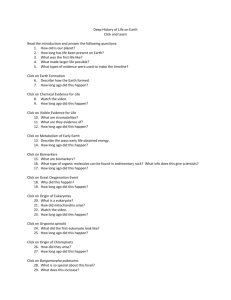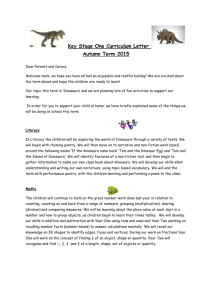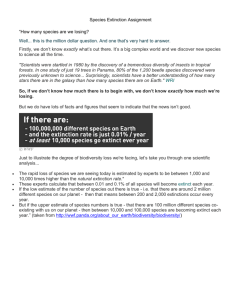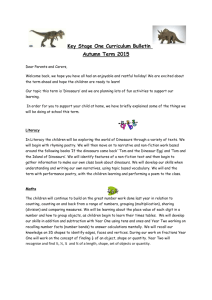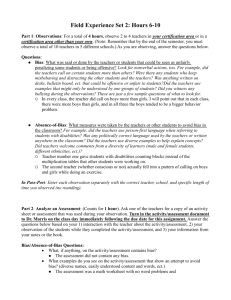Level 2 Earth and Space Science internal
advertisement
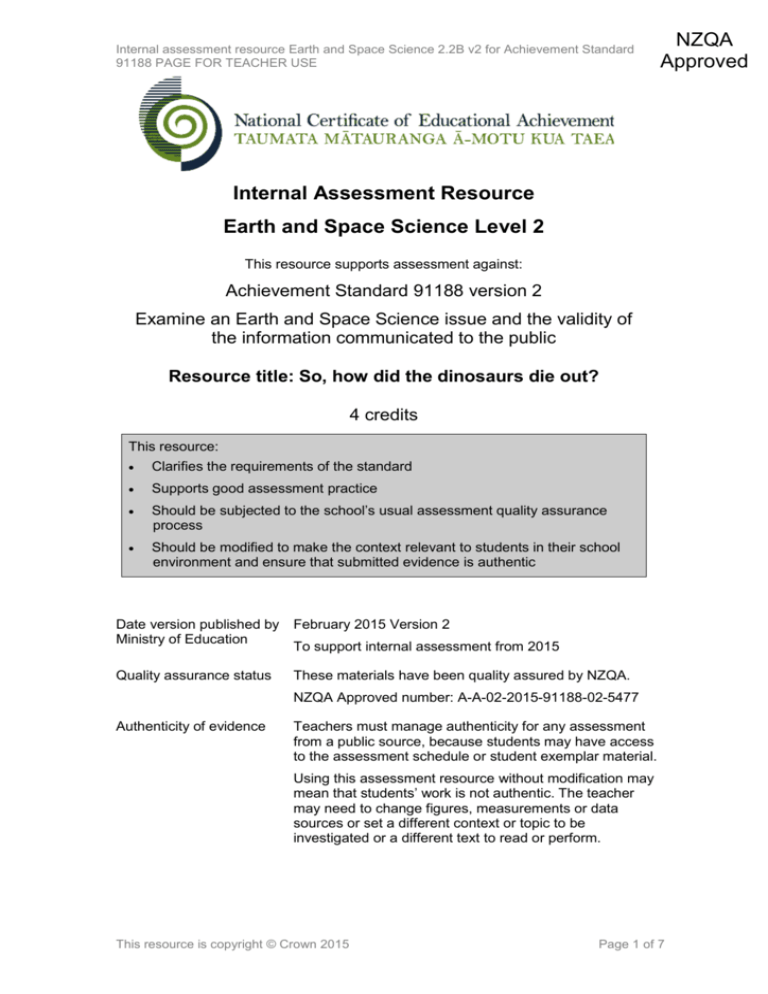
Internal assessment resource Earth and Space Science 2.2B v2 for Achievement Standard 91188 PAGE FOR TEACHER USE NZQA Approved Internal Assessment Resource Earth and Space Science Level 2 This resource supports assessment against: Achievement Standard 91188 version 2 Examine an Earth and Space Science issue and the validity of the information communicated to the public Resource title: So, how did the dinosaurs die out? 4 credits This resource: Clarifies the requirements of the standard Supports good assessment practice Should be subjected to the school’s usual assessment quality assurance process Should be modified to make the context relevant to students in their school environment and ensure that submitted evidence is authentic Date version published by February 2015 Version 2 Ministry of Education To support internal assessment from 2015 Quality assurance status These materials have been quality assured by NZQA. NZQA Approved number: A-A-02-2015-91188-02-5477 Authenticity of evidence Teachers must manage authenticity for any assessment from a public source, because students may have access to the assessment schedule or student exemplar material. Using this assessment resource without modification may mean that students’ work is not authentic. The teacher may need to change figures, measurements or data sources or set a different context or topic to be investigated or a different text to read or perform. This resource is copyright © Crown 2015 Page 1 of 7 Internal assessment resource Earth and Space Science 2.2B v2 for Achievement Standard 91188 PAGE FOR TEACHER USE Internal Assessment Resource Achievement Standard Earth and Space Science 91188: Examine an Earth and Space Science issue and the validity of the information communicated to the public Resource reference: Earth and Space Science 2.2B v2 Resource title: So, how did the dinosaurs die out? Credits: 4 Teacher guidelines The following guidelines are designed to ensure that teachers can carry out valid and consistent assessment using this internal assessment resource. Teachers need to be very familiar with the outcome being assessed by the Achievement Standard Earth and Space Science 91188. The achievement criteria and the explanatory notes contain information, definitions, and requirements that are crucial when interpreting the standard and assessing students against it. Context/setting This assessment activity requires students to investigate the accuracy of claims that an Asteroid wiped out the dinosaurs 65 million years ago. You will need to have taught students the relevant science concepts related to the extinction of dinosaurs such as geological time and what is the K/T boundary. You will also need to familiarise them with the terms such as validity, bias, assumptions, and accuracy. Giving students examples of news articles that display bias or inaccuracies or aren’t based on valid and reliable science will help students in their investigation. The context of this activity could be changed to one that is relevant to your classroom programme or one that students would like to investigate. Conditions Students will complete this assessment activity individually. It will take around ten to fifteen hours of in- and out-of-class time. Monitoring students’ progress will help them progress through this assessment. Students will record their investigation and progress in a logbook and keep all of their resources to help them write their report. You will need to tell them how to use a logbook, and how to process resources by highlighting, making notes from the resources, collating, listing, and sorting resources. You can make sure their work is authentic by: conducting interviews with the student having signed agreements with the student and/or parents or caregivers checking student’s resources having students provide a bibliography in a Word document which names all the resources they have used and referred to. This resource is copyright © Crown 2015 Page 2 of 7 Internal assessment resource Earth and Space Science 2.2B v2 for Achievement Standard 91188 PAGE FOR TEACHER USE Resource requirements Students can use information and news articles from the Internet, newspapers, TV, magazines, books, blogs, and advertisements. The focus is on students looking critically at the scientific information. Students need to be able to explain the scientific information presented to the public in terms of: its accuracy how valid and/or biased the information is assumptions made about the information accuracy of communication of the information. Students need to state their position on the information from an Earth and Space Science perspective and be able to justify their position by making justified links between their stated position and science reasons for this position. Some suitable websites are: http://www.pbs.org/wgbh/evolution/extinction/dinosaurs/low_bandwidth.html http://www.royalsociety.org.nz http://earthsky.org/biodiversity/did-volcanoes-kill-the-dinosaurs http://www.sciencedaily.com/releases/2009/04/090427010803.htm http://www.universetoday.com/guide-to-space/earth/k-t-boundary/ http://www.allaboutcreation.org/dinosaur-extinction.htm. Background information websites: http://www.ucmp.berkeley.edu/help/timeform.php http://science.nationalgeographic.com/science/prehistoric-world/prehistoric-timeline.html - great site to explain geological time simply. http://geology.com/time.htm - printable geological time scale suggest identification of K/T time on this scale. http://www.talktalk.co.uk/reference/encyclopaedia/hutchinson/m0031391.html. Additional information None. This resource is copyright © Crown 2015 Page 3 of 7 Internal assessment resource Earth and Space Science 2.2B v2 for Achievement Standard 91188 PAGE FOR STUDENT USE Internal Assessment Resource Achievement Standard Earth and Space Science 91188: Examine an Earth and Space Science issue and the validity of the information communicated to the public Resource reference: Earth and Space Science 2.2B v2 Resource title: So, how did the dinosaurs die out? Credits: 4 Achievement Achievement with Merit Achievement with Excellence Examine an Earth and Space Science issue and the validity of the information communicated to the public. Examine in depth an Earth and Space Science issue and the validity of the information communicated to the public. Examine comprehensively an Earth and Space Science issue and the validity of the information communicated to the public. Student instructions Introduction This assessment activity requires you to evaluate information presented to the public about how the dinosaurs became extinct 65 million years ago. This is an individual assignment and all work should be your own. Research Research public reports about how the dinosaurs became extinct 65 million years ago. Your teacher may provide you with some starting points. You can look at information presented to the public in the following formats: newspaper articles, books, journals, pamphlets, websites, television programmes, films, blogs and advertisements. Use your research to evaluate, from an Earth and Space Science perspective, the issue and the scientific information presented to the public. Record all information you accessed in your logbook – perhaps saving the sources as a word document will help you when it comes to presenting your report. Your information needs to be processed in your logbook. Processing will involve: sorting out the relevant information highlighting, underlining or copying down relevant information listing key points and relevant aspects from your information. This resource is copyright © Crown 2015 Page 4 of 7 Internal assessment resource Earth and Space Science 2.2B v2 for Achievement Standard 91188 PAGE FOR STUDENT USE The processing can be shown by written notes in your logbook and / or by notes and highlighting on your photocopied or printed-out material. When writing your report, you need to consider and be able to explain the aspects given in the bullet points below (if relevant to that information source) for at least two sources. You need to consider and comment on: how accurate the information presented is (Is it factually correct and/or are the facts presented in such a way so that the audience only sees one point of view?) the validity and bias of the information Validity refers to the accuracy of the information. Valid information is based on good scientific information that is collected using scientific methods and is reliable i.e. backed up by other research or sources of information. Bias is where the author may have a particular point of view. A biased article may be valid even though it is one-sided. how the author collected the information, and the assumptions they made about the information they were presenting to the public the accuracy of the presentation of the information. It is not enough just to state that a source of information such as a news article is (or is not) biased or valid – you must comment on and give reasons why it is biased or not biased, or valid or not valid, and any inaccuracies in the information presented. Report Use the information you have gathered in your logbook to write a report - an explanation and evaluation of the Earth and Space Science information that is presented to the public. This should include: a discussion of the issue the accuracy of the presentation of the information (is it slanted or skewed?) validity and bias (describe the validity and bias of the information presented) any assumptions that are made about the scientific information how accurate the communication of the information is. An explanation involves providing an in-depth report on the issue and an evaluation of the information presented to the public. This means reasons should be given for explanations. To evaluate comprehensively information presented to the public means that explanations of the issue are justified. Reasons are elaborated upon with links made between them and the information provided. Write a statement that outlines your position on the issue and information presented. In your statement you should explain why you have this position (or view) based on scientific information that you have researched. Hand in your report and logbook by the date agreed with your teacher. This resource is copyright © Crown 2015 Page 5 of 7 Internal assessment resource Earth and Space Science 2.2B v2 for Achievement Standard 91188 PAGE FOR TEACHER USE Assessment schedule: Earth and Space Science 91188 So, how did the dinosaurs die out? Evidence/Judgements for Achievement Evidence/Judgements for Achievement with Merit The student has produced a logbook and a report in which they examine the selected issue and the validity of the information communicated to the public. The student has produced a logbook and a report in which they examine in depth the selected issue and the validity of the information communicated to the public. The student has produced a logbook and a report in which they examine comprehensively the selected issue and the validity of the information communicated to the public. The logbook and report demonstrate that the student has selected and processed (e.g. sorted, highlighted, taken notes from) information from at least two sources. The logbook and report demonstrate that the student has selected and processed (e.g. sorted, highlighted, taken notes from) information from at least two sources. The logbook and report demonstrate that the student has selected and processed (e.g. sorted, highlighted, taken notes from) information from at least two sources. The student’s report describes the scientific issue. For example: Dinosaurs were made extinct by an asteroid hitting the earth 65 million years ago. The student’s report provides an explanation of the scientific issue, including where relevant: the accuracy of the information the validity and bias of the information the assumptions made about the information the accuracy of the communication of the information. The student’s report provides and explanation of the scientific issue, including where relevant: the accuracy of the information the validity and bias of the information the assumptions made about the information the accuracy of the communication of the information. The student’s report describes, where relevant: the accuracy of the information the validity and bias of the information the assumptions made about the information the accuracy of the communication of the information. For example: The Royal Society Alpha publication http://www.royalsociety.org.nz/teachinglearning/resources/alpha/116/ is referenced and supported by reputable science organisations such as governments and the Foundation for Research, Science, and Technology. This resource is copyright © Crown 2015 For example: The Alpha publication explains that a thin layer of clay at the K/T boundary has been found all over the world that contains a high level of Iridium, which is extremely rare on earth but is abundant in meteorites. A big assumption in this Alpha publication is that Iridium can only be from meteorites. However, (http://www.sciencedaily.com/releases/2009/04/090 427010803.htm) and (http://www.pbs.org/wgbh/evolution/extinction/dinos aurs/volcanism.html) give evidence that explains Iridium can also come from molten rock inside the Evidence/Judgements for Achievement with Excellence The student’s report justifies a position related to the information. For example: Extinction of the Dinosaurs is more likely to be from a combination of Volcanism and Asteroid as the Asteroid and Volcanism can both explain the observation that Iridium is found at the K/T boundary whereas the Volcanism theory can account for the lava flows that cover a huge area of Deccan area in India that are very deep. Page 6 of 7 Internal assessment resource Earth and Space Science 2.2B v2 for Achievement Standard 91188 PAGE FOR TEACHER USE This information is valid due to it being based on scientific research. However, it shows bias (backed up with evidence) towards asteroids being the only reason that dinosaurs became extinct. This publication is aimed at secondary school students but the words used are really long so it is assumed that students will understand these, which is not always the case. earth, giving weight to the Volcanism theory of what lead to the extinction of dinosaurs. The students report explains a position related to the information. This information is accurate and backed up by references. For example: Asteroid impact may be the reason that dinosaurs died out but it is more likely that this in conjunction with Volcanism lead to their extinction. This is because both theories can explain the high level of Iridium at the K/T boundary. The student’s report describes a position related to the information. Sources (at least two) are recorded in a traceable reference system. The asteroid theory accounts for the observation of the impact crater in Mexico and also the advent of melted rock that are commonly found at the K/T boundary. Sources (at least two) are recorded in a traceable reference system. For example: There is a large amount of evidence that indicates that an Asteroid impact on earth lead to dinosaurs becoming extinct. Sources (at least two) are recorded in a traceable reference system. Final grades will be decided using professional judgement based on a holistic examination of the evidence provided against the criteria in the Achievement Standard. This resource is copyright © Crown 2015 Page 7 of 7

